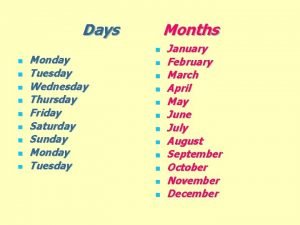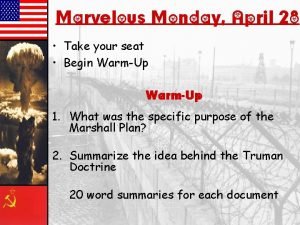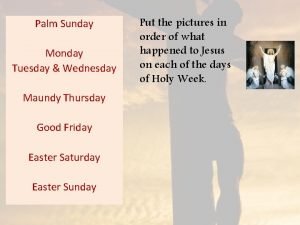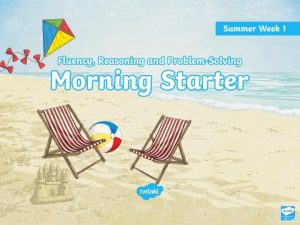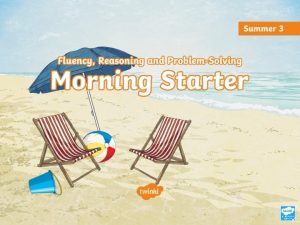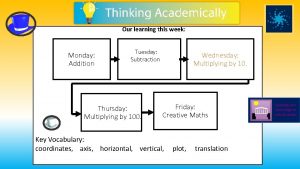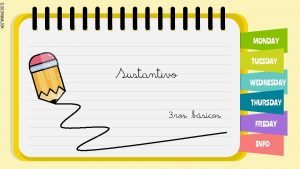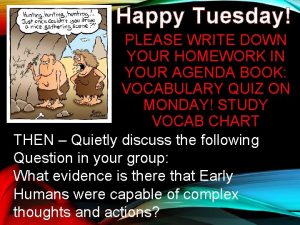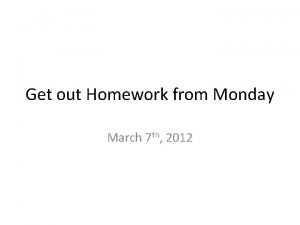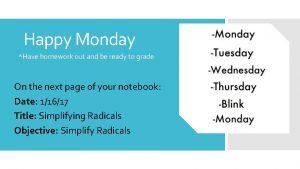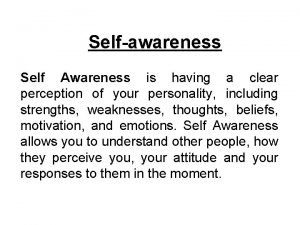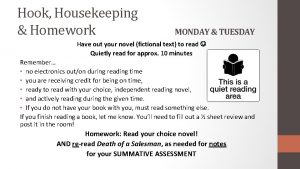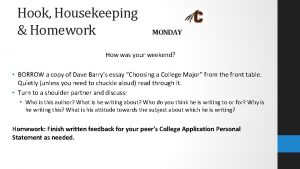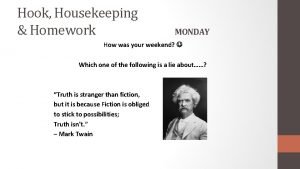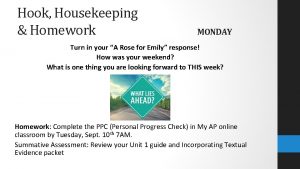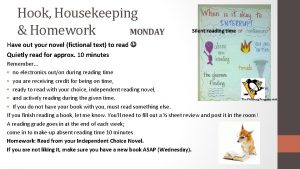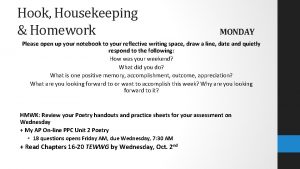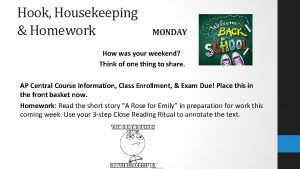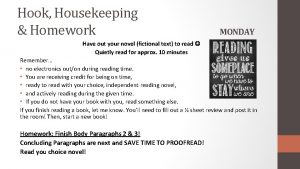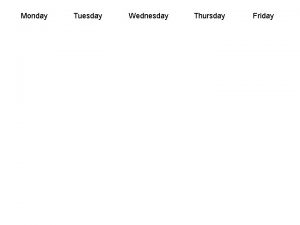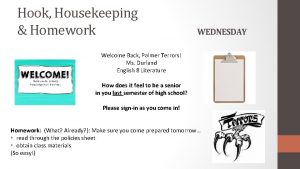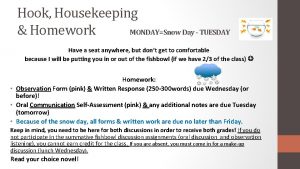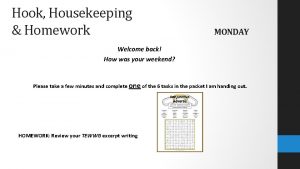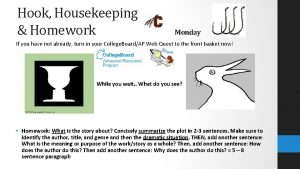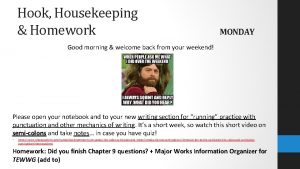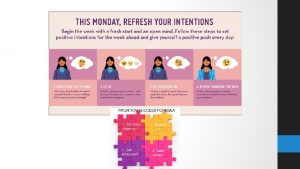Monday Tuesday Hook Housekeeping Homework WEDNESDAY Clear your






















- Slides: 22

Monday

Tuesday

Hook, Housekeeping & Homework WEDNESDAY Clear your desks of electronics and other materials not related to this class. You will need a couple of blank sheets of notebook paper and a blue or black pen! Homework: Independent Novel Inquiry Project – Timed Writing Coming Next Week – Have you read your novel?

Past, Present, Future WEDNESDAY • Percy Bysshe Shelley’s “Ozymandias” • Peer models & self assessment of prose passage timed writing • Independent Inquiry Reading Time • In-class Timed Writing • Independent Novel Inquiry Project – Timed Writing Next Week! • Some more poetry analysis models – Another Written Post-Assessment!

The Power of Poetry AP = Always Poetry Standard 2: Reading for All Purposes 1. Literary criticism of complex texts requires the use of analysis, interpretive, and evaluative strategies Objective: to use analytical and interpretive strategies to analyze a poem. Relevance: The ability to interpret a variety of texts and cite evidence fosters the coherent thinking, speaking, and writing, which are priority skills for the workplace and postsecondary settings. Essential Questions: What language do we use when analyzing poetry? How do various techniques and devices, including structure/form, effect audience understanding and impact the purpose of a text? What are the forms and conventions of a sonnet?

Activity: Develop & Apply Purpose: to practice our analytical strategies for a written analysis Tasks: • Read and dissect the prompt – turn it into a question! • Read (x 2) and annotate the poem using TPCASTT (FOCUSING ON THE PROMPT) • THEN, how would you respond to the writing prompt? Outline (star, number, arrow) essay ideas, including… • • a complete (possibly closed) thesis statement that RESPONDS to the prompt (and identifies the poem’s meaning as a whole), followed by points (what? ), specific illustrations (lines, phrases = how? ), identifying and explaining the poetic terminology to which you would refer (how? ) • NOW, write your essay, including ideas above AND… • explaining the meaning, purpose and effect, supporting your point (why? So what? ), - consider every “I” should have at least 2 “Es” • and, most importantly, elaboration ideas and a concluding idea that conveys how these support the meaning (so what? !) • STOP! Essay check (re-read your thesis: Are you supporting it? + Check your time & outlined ideas: What do you need to accomplish? ) • SAVE TIME to re-read (edit, proofread) Outcome: Staple your assessment under the poem and turn it in!

Review & Release REVIEW • TPCASTT Staple your assessment under the poem and turn it in! + BRING YOUR NOVEL TOMORROW IN CASE YOU HAVE TIME TO READ • What is the subject matter? • What is the (complex) attitude (tone) of the speaker towards the subject matter? • Is it complimentary or shifting? • How does the structure of the poem support the attitude? • • Is there a volta? Where? How? What is the conclusion? (couplet? ) • How do other literary elements support this tone and meaning of the work as a whole (conclusion)? Imagery, figurative language, etc. ? • Tone Lists • Literary/Poetry Terminology + FORM & STRUCTURE • Practice poems (PIEE charts - models) • How to Write a Statement of Theme • Introductory Paragraphs – Thesis Statements (SAK) - PIE – Concluding Paragraphs (You have handouts!) Homework: Independent Novel Inquiry Project

Hook, Housekeeping & Homework It’s ben a crazy week, so let’s get even more crazy = Time for some more Po-Jokes! What did the poet say to Luke Skywalker? “Metaphors be with you. ” What is a metaphor? For grazin’ yer cattle. What is a simile? It’s like a metaphor. How do poets say hello? Hey, haven’t we metaphor? Why did the boy poet introduce himself to the girl poet? Because he wanted to meter. How does a poet sneeze? Haiku!!! Why are poets always so poor? Because rhyme doesn’t pay. THURSDAY WERE YOU ABSENT YESTERDAY? SEE ME NOW! HOMEWORK: Review for another poetry assessment “Free Response: the 40 minute essay” – Did you read annotate? + Independent Novel Inquiry = MWIO for your Novel • Post Assessment next week (Wednesday)! BE HERE.

Past, Present, Future THURSDAY • Echo Sonnet – Practice • “Free Response: the 40 minute essay” – Read annotate now • Model, self-assessment (scoring guide, too), review work • MWIO for your novel • Another poetry written post-assessment • Independent Inquiry Novel - review (MWIO for your novel) and assessment

The Power of Poetry AP = Always Poetry Standard 2: Reading for All Purposes 1. Literary criticism of complex texts requires the use of analysis, interpretive, and evaluative strategies Objective: to use analytical and interpretive strategies to analyze a poem. Relevance: The ability to interpret a variety of texts and cite evidence fosters the coherent thinking, speaking, and writing, which are priority skills for the workplace and postsecondary settings. Essential Questions: What language do we use when analyzing poetry? How do various techniques and devices, including structure/form, effect audience understanding and impact the purpose of a text? What are the forms and conventions of a sonnet?

Activities: Develop We Do Purpose: to prepare for our post-assessment by identifying the points, illustrations, and explanations/elaborations used to receive an AP 9/6 score Tasks: First, let’s share and compare what we came up with (annotations & essay) Then… 1. Carefully read through the given high scoring AP essay 2. Pause & discuss the essay with the large group (see next after) • • • thesis statement that identifies the poem’s meaning as a whole, followed by outlined points, specific illustrations (lines, phrases), identifying/labeling the poetic terminology to which you would refer and, most importantly, explanation/elaboration ideas that conveys how these support the meaning

Student Sample 1 A Introductory Paragraph • Introduce subject (genre, “title, ” author) – action verb – general statement of point of view (narrator questions, alter ego answers) • Explains narrator voice (timid) vs. alter ego’s (forms prospect of life) • Thesis: • Address prompt: form (sonnet w/ addendums) • Address prompt: literary devices (symbols, juxtaposition, imagery) • Address prompt: meaning (form+ lit devices = important to take “leaps” in life) • How did you do? Identify what you have, and note what you don’t! • See next

Activity: Develop & Apply YOU Do Plus/Delta Introduction • Attention grabbing hook (if time) • Dramatic situation • Universal/enduring understanding • Closed thesis Score yourself (0 or 1) on the scoring Guide Model Introduction Science: trying to lower the mortality rate and even trying to make us look younger as we age. Sadly, though, we humans are mere mortals and our bodies change with each year of life towards death. The anxiety that a person may feel as he ages and approaches death is expressed in “Sonnet 73” by William Shakespeare. Through a series of metaphors and vivid imagery, the speaker’s pensive comparisons become increasingly more relevant to the ultimate exhortation to be “loved well” before he is gone.

Student Sample 1 A Continued Body Paragraph 1 Point (form enhances understanding) • Explains (voice = people’s fears/insecurities about the future) • Elaborates (sharing this = reader attachment) o Illustration of form/structure (1 -word addendums that rhymes to last word of each line) o Explains (provides immediate answers to questions) o Elaborates (mono-rhymic = memorable, touching for reader) • Illustration of form/structure (1 st quatrain, general questions = starting a life from blank) • Explains (title=sonnet created by “echo” providing answers) • Elaborates (“empty page” = metaphor for voice) • Explains (illustration of inquiry words, answered only by 1 word = stronger impact) • Illustrates (first question, answers “start”) • Explains (meaning = the most important thing is to take the first step) o Additional illustration (juxtaposition of joy & grief) o Explains (shows echo’s sincerity) o Elaborates (not just blindly coaxing, instead giving real answers) o Additional illustration (art and “leaf” = synecdoche for nature) o Explains (provides consolation/relief to ailing heart) • How did you do? • Identify what you have, and note what you don’t!

Student Sample 1 A Continued Body Paragraph 2 • Point (structure transition, 2 nd quatrain = naturalistic symbols) • Illustrates/Explains (life of leaf = visual imagery; final fate is death) • Explains • Elaborates • Illustrates • Explains meaning Continue through the rest of the essay & really note what is done in the final paragraph (the conclusion – see next) Outcome: How did you do? What do you need to continue to do? What do you need to work on? Score yourself (6 - 0) on the Scoring Guide

Activity: Develop & Apply YOU Do Plus/Delta Conclusion • Connect to the opening ideas – Restate thesis or main idea – • End with something for the reader to consider or to make the reader think “One thing is for sure: the ‘page’ will not be ‘empty’ anymore. ” Model Conclusion Through “Sonnet 73”, Shakespeare structures a progression of vivid metaphors to show the ravages of time on one’s physical being as well as presenting the mental anguish one may feel as he moves from youth closer to death. The realization that life will not be as cyclical in nature as the first and second quatrains seem to suggest, brings our speaker to acknowledge his listener’s awareness of his demise and conclude that not only should he be loved before he is gone but also that the listener's youth will, too, leave him in the future. Through “Sonnet 73, ” Shakespeare shares advice and a reality that we should all heed at any age.

Instruction: Obtain Activity: Apply Sample: 1 A Score: 9 on older rubric – 6 on newer • From its early distinction between the voice and echo in Pack’s poem, this elegant essay inspires confidence. Using a welldeveloped introduction to identify the poem’s form and explicate its structure — “[t]he ‘echo’ … is the narrator’s alter ego” — the essay explores the literary devices the poet works with, including rhyme, imagery, and symbol, and connects them to the poem’s meaning. The discussion of the interplay between voice and echo is rich: “The echo is not just blindly trying to coax or comfort the voice, but he exists to give real answers. ” The essay suggests a student fully engaged in a conversation with the work — reader response at its best — and the probing goes deeper, to “the central idea of this sonnet — we all know we must die, and that our fate is sealed due to the inevitable mortality. Yet the echo says, ‘leap’ for the future. ” Such thoroughness, persuasiveness, and insight, combined with an especially effective control of language, earned this essay a score of 9. Sample 1 B = 5; Sample 1 C = 2 – older rubric https: //secure-media. collegeboard. org/apc/ap 11_english_lit_form_b_q 1. pdf Sophistication: Score yourself (1 or 0) on the Scoring Guide What are two POSITIVES to make sure you rock this next assessment?

Review & Release Prepare for another poetry assessment! • “Free Response: the 40 minute essay” - What strategies in here could be most helpful to you and your process? • TPCASTT • What is the subject matter? • What is the (complex) attitude (tone) of the speaker towards the subject matter? • Is it complimentary or shifting? • How does the structure of the poem support the attitude? • • Is there a volta? Where? How? What is the conclusion? (couplet? ) • How do other literary elements support this tone and meaning of the work as a whole (conclusion)? Imagery, figurative language, etc. ? • Tone Lists • Literary/Poetry Terminology + FORM & STRUCTURE • Practice poems (PIEE charts - models) • How to Write a Statement of Theme • Introductory Paragraphs – Thesis Statements (SAK) - PIE – Concluding Paragraphs (You have handouts!) + Independent Novel Inquiry Project = MWIO for your Novel

Hook, Housekeeping & Homework FRIDAY Clear your desks of electronics and other materials not related to this class. You will need a couple of blank sheets of notebook paper and a blue or black pen! Let’s finish this unit strong!

Show What You Know Purpose: to show what you know about analyzing and interpreting poetry Tasks: 1. Clear your desk except for a few sheets of loose-leaf notebook paper and a pen 2. Read and dissect/annotate the prompt 3. Read (x 2) and annotate the poem (TPCASTT) 4. Rough outline + thesis 5. Write final copy 6. Proofread Outcome: Staple scoring guide ON TOP of your essay (prompt/poem facing down) and turn in to front basket Scoring guide - prompt/poem – essay

Review and Release Staple poem on top and turn in by the bell. ENJOY YOUR WEEKEND! MWIO for your Independent Inquiry Novel – by Wednesday.

Coming Soon…
 Monday tuesday wednesday thursday friday calendar
Monday tuesday wednesday thursday friday calendar Monday tuesday wednesday thursday friday saturday sunday
Monday tuesday wednesday thursday friday saturday sunday Marvelous monday terrific tuesday wonderful wednesday
Marvelous monday terrific tuesday wonderful wednesday Enum day sunday=6 monday tuesday wednesday
Enum day sunday=6 monday tuesday wednesday Sunday monday tuesday wednesday thursday friday saturday
Sunday monday tuesday wednesday thursday friday saturday Sunday monday tuesday wednesday
Sunday monday tuesday wednesday Monday=621 tuesday=732 wednesday=933
Monday=621 tuesday=732 wednesday=933 Monday=621 tuesday=732 wednesday=933
Monday=621 tuesday=732 wednesday=933 On monday and tuesday
On monday and tuesday Slides mania
Slides mania Last weekend essay
Last weekend essay Tuesday homework
Tuesday homework Did you finish your homework?
Did you finish your homework? Homework for monday
Homework for monday Homework for monday
Homework for monday Homework oh homework i hate you you stink
Homework oh homework i hate you you stink Homework oh homework i hate you you stink
Homework oh homework i hate you you stink Parts of a poem
Parts of a poem Homework oh homework
Homework oh homework Alitteration definition
Alitteration definition When she sings her voice is like velvet
When she sings her voice is like velvet Self awareness is having a clear perception of
Self awareness is having a clear perception of Wednesday evening prayer
Wednesday evening prayer

